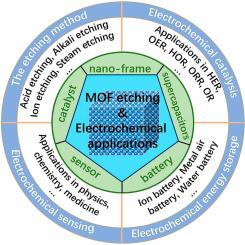当前位置:
X-MOL 学术
›
Coord. Chem. Rev.
›
论文详情
Our official English website, www.x-mol.net, welcomes your feedback! (Note: you will need to create a separate account there.)
Etching MOF nanomaterials: Precise synthesis and electrochemical applications
Coordination Chemistry Reviews ( IF 20.3 ) Pub Date : 2024-06-25 , DOI: 10.1016/j.ccr.2024.216016 Qifei Chen , Mengqi Yao , Yuqi Zhou , Yangyang Sun , Guangxun Zhang , Huan Pang
Coordination Chemistry Reviews ( IF 20.3 ) Pub Date : 2024-06-25 , DOI: 10.1016/j.ccr.2024.216016 Qifei Chen , Mengqi Yao , Yuqi Zhou , Yangyang Sun , Guangxun Zhang , Huan Pang

|
Metal–organic frameworks (MOFs) have been employed for applications in the territory of physics, chemistry, biology, medicine and other fields because of its extensive pore size, high specific surface area, and adjustable structures. Nonetheless, traditional MOFs lack stability and electrical conductivity. Etching strategies can create richer defects and metal active sites for MOFs and their derivative nanomaterials, which largely broadens their electrochemistry applications. Therefore, effective etching strategies are crucial for improving the performance of traditional MOFs. In this review, universal etching methods for MOFs such as acid etching, alkali etching, ion etching, in-situ etching are introduced in detail. Their electrochemical applications are highlighted, including the electrocatalysis, sensing, and electrochemical energy storage, such as metal ion batteries, air batteries, supercapacitors, etc. What’s more, the future development trends and challenges of etching MOF nanomaterials are also described.
中文翻译:

蚀刻MOF纳米材料:精确合成和电化学应用
金属有机框架(MOF)因其大孔径、高比表面积和可调节结构而在物理、化学、生物、医学等领域得到广泛应用。尽管如此,传统的 MOF 缺乏稳定性和导电性。蚀刻策略可以为 MOF 及其衍生纳米材料创造更丰富的缺陷和金属活性位点,这在很大程度上拓宽了它们的电化学应用。因此,有效的刻蚀策略对于提高传统MOF的性能至关重要。本文详细介绍了酸刻蚀、碱刻蚀、离子刻蚀、原位刻蚀等MOFs通用刻蚀方法。重点介绍了它们的电化学应用,包括电催化、传感和电化学储能,如金属离子电池、空气电池、超级电容器等。此外,还描述了刻蚀MOF纳米材料的未来发展趋势和挑战。
更新日期:2024-06-25
中文翻译:

蚀刻MOF纳米材料:精确合成和电化学应用
金属有机框架(MOF)因其大孔径、高比表面积和可调节结构而在物理、化学、生物、医学等领域得到广泛应用。尽管如此,传统的 MOF 缺乏稳定性和导电性。蚀刻策略可以为 MOF 及其衍生纳米材料创造更丰富的缺陷和金属活性位点,这在很大程度上拓宽了它们的电化学应用。因此,有效的刻蚀策略对于提高传统MOF的性能至关重要。本文详细介绍了酸刻蚀、碱刻蚀、离子刻蚀、原位刻蚀等MOFs通用刻蚀方法。重点介绍了它们的电化学应用,包括电催化、传感和电化学储能,如金属离子电池、空气电池、超级电容器等。此外,还描述了刻蚀MOF纳米材料的未来发展趋势和挑战。






































 京公网安备 11010802027423号
京公网安备 11010802027423号